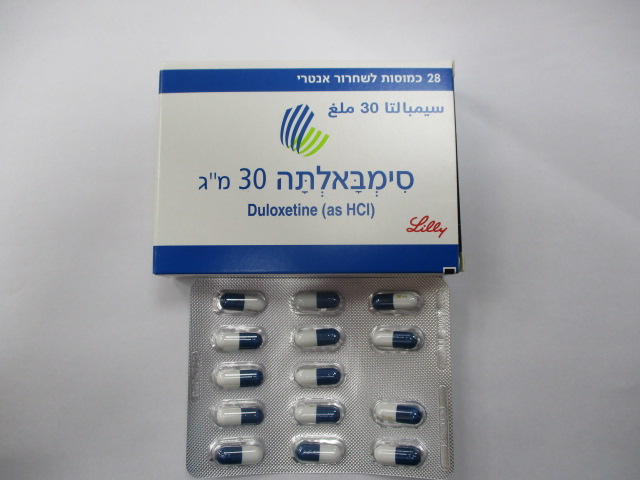Quest for the right Drug

סימבאלתה 30 מ"ג CYMBALTA 30 MG (DULOXETINE AS HYDROCHLORIDE)
תרופה במרשם
תרופה בסל
נרקוטיקה
ציטוטוקסיקה
צורת מתן:
פומי : PER OS
צורת מינון:
אין פרטים : GASTRO RESISTANT CAPSULES
עלון לרופא
מינוניםPosology התוויות
Indications תופעות לוואי
Adverse reactions התוויות נגד
Contraindications אינטראקציות
Interactions מינון יתר
Overdose הריון/הנקה
Pregnancy & Lactation אוכלוסיות מיוחדות
Special populations תכונות פרמקולוגיות
Pharmacological properties מידע רוקחי
Pharmaceutical particulars אזהרת שימוש
Special Warning עלון לרופא
Physicians Leaflet
Pharmacological properties : תכונות פרמקולוגיות
Pharmacodynamic Properties
12.2 Pharmacodynamics Preclinical studies have shown that duloxetine is a potent inhibitor of neuronal serotonin and norepinephrine reuptake and a less potent inhibitor of dopamine reuptake. Duloxetine has no significant affinity for dopaminergic, adrenergic, cholinergic, histaminergic, opioid, glutamate, and GABA receptors in vitro. Duloxetine does not inhibit monoamine oxidase (MAO). CYMBALTA is in a class of drugs known to affect urethral resistance. [see Warnings and Precautions (5.15)]. Cardiac Electrophysiology The effect of CYMBALTA 160 mg and 200 mg administered twice daily (2.7 and 3.3 times the maximum recommended dosage, respectively) to steady state was evaluated in a randomized, double-blinded, two-way crossover study in 117 healthy female adult subjects. No QT interval prolongation was detected. CYMBALTA appears to be associated with concentration-dependent but not clinically meaningful QT shortening.
Pharmacokinetic Properties
12.3 Pharmacokinetics Duloxetine has an elimination half-life of about 12 hours (range 8 to 17 hours) and its pharmacokinetics are dose proportional over the therapeutic range. Steady-state plasma concentrations are typically achieved after 3 days of dosing. Elimination of duloxetine is mainly through hepatic metabolism involving two P450 isozymes, CYP1A2 and CYP2D6. Absorption After oral CYMBALTA administration duloxetine hydrochloride is well absorbed. There is a median 2 hour lag until absorption begins (Tlag), with maximal plasma concentrations (Cmax) of duloxetine occurring 6 hours post dose. There is a 3 hour delay in absorption and a one -third increase in apparent clearance of duloxetine after an evening dose as compared to a morning dose Effect of food: Food does not affect the Cmax of duloxetine, but delays the time to reach peak concentration from 6 to 10 hours and it marginally decreases the extent of absorption (AUC) by about 10%. Distribution The apparent volume of distribution averages about 1640 L. Duloxetine is highly bound (>90%) to proteins in human plasma, binding primarily to albumin and α1-acid glycoprotein. The interaction between duloxetine and other highly protein bound drugs has not been fully evaluated. Plasma protein binding of duloxetine is not affected by renal or hepatic impairment. Elimination Metabolism Biotransformation and disposition of duloxetine in humans have been determined following oral administration of 14 C-labeled duloxetine. Duloxetine comprises about 3% of the total radiolabeled material in the plasma, indicating that it undergoes extensive metabolism to numerous metabolites. The major biotransformation pathways for duloxetine involve oxidation of the naphthyl ring followed by conjugation and further oxidation. Both CYP1A2 and CYP2D6 catalyze the oxidation of the naphthyl ring in vitro. Metabolites found in plasma include 4-hydroxy duloxetine glucuronide and 5- hydroxy, 6-methoxy duloxetine sulfate. Excretion Many additional metabolites have been identified in urine, some representing only minor pathways of elimination. Only trace (<1% of the dose) amounts of unchanged duloxetine are present in the urine. Most (about 70%) of the duloxetine dose appears in the urine as metabolites of duloxetine; about 20% is excreted in the feces. Duloxetine undergoes extensive metabolism, but the major circulating metabolites have not been shown to contribute significantly to the pharmacologic activity of duloxetine.

פרטי מסגרת הכללה בסל
השימוש בתרופות לטיפול בכאב נוירופתי יבוצעו בהתאם להנחיות הקליניות המקצועיות המתעדכנות מזמן לזמן על פי המידע העדכני בתחום הטיפול במחלה. התחלת הטיפול בתרופות אלו תיעשה על פי המלצת מרפאת כאב או על פי מרשם של רופא מומחה בכאב או בנוירולוגיה או בסוכרת או בהרדמה או באונקולוגיה
מסגרת הכללה בסל
התוויות הכלולות במסגרת הסל
| התוויה | תאריך הכללה | תחום קליני | Class Effect | מצב מחלה |
|---|---|---|---|---|
| לטיפול בכאב נוירופתי | 01/11/2006 |
שימוש לפי פנקס קופ''ח כללית 1994
לא צוין
תאריך הכללה מקורי בסל
01/11/2006
הגבלות
תרופה מוגבלת לרישום ע'י רופא מומחה או הגבלה אחרת
מידע נוסף
עלון מידע לצרכן
12.04.18 - עלון לצרכן 09.01.22 - עלון לצרכן אנגלית 09.01.22 - עלון לצרכן עברית 09.01.22 - עלון לצרכן ערבית 15.09.23 - עלון לצרכן עברית 27.10.23 - עלון לצרכן אנגלית 27.10.23 - עלון לצרכן ערבית 28.08.24 - עלון לצרכן עברית 27.09.24 - עלון לצרכן אנגלית 27.09.24 - עלון לצרכן ערבית 15.06.15 - החמרה לעלון 03.03.16 - החמרה לעלון 28.02.17 - החמרה לעלון 03.05.20 - החמרה לעלון 29.03.21 - החמרה לעלון 15.12.21 - החמרה לעלון 22.10.23 - החמרה לעלון 28.08.24 - החמרה לעלוןלתרופה במאגר משרד הבריאות
סימבאלתה 30 מ"ג